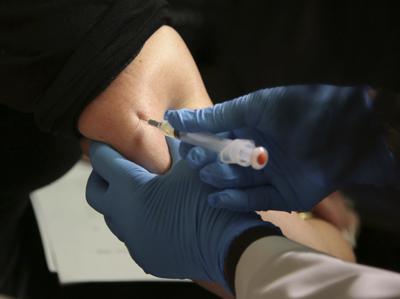This year is not yet one-third over, yet measles cases in the United States are on track to be the worst since a massive outbreak in 2019. At the same time, anti-vaccine activists are recklessly sowing doubts and encouraging vaccine hesitancy. Parents who leave their children unvaccinated are risking not only their health but also the well-being of those around them.
Measles is one of the most contagious human viruses — more so than the coronavirus — and is spread through direct or airborne contact when an infected person breathes, coughs or sneezes. The virus can hang in the air for up to two hours after an infected person has left an area. It can cause serious complications, including pneumonia, encephalitis and death, especially in unvaccinated people. According to the Centers for Disease Control and Prevention, one person infected with measles can infect 9 out of 10 unvaccinated individuals with whom they come in close contact.
But measles can be prevented with the measles, mumps and rubella vaccine; two doses are 97 percent effective. When 95 percent or more of a community is vaccinated, herd immunity protects the whole. Unfortunately, vaccination rates are falling. The global vaccine coverage rate of the first dose, at 83 percent, and second dose, at 74 percent, are well under the 95 percent level. Vaccination coverage among U.S. kindergartners has slipped from 95.2 percent during the 2019-2020 school year to 93.1 percent in the 2022-2023 school year, according to the CDC, leaving approximately 250,000 kindergartners at risk each year over the past three years.
The virus is slipping through the gaps. According to the World Health Organization, in 2022, 37 countries experienced large or disruptive measles outbreaks compared with 22 countries in 2021. In the United States, there have been seven outbreaks so far this year, with 121 cases in 18 jurisdictions. Most are children. Many of the outbreaks in the United States appear to have been triggered by international travel or contact with a traveler. Disturbingly, 82 percent of those infected were unvaccinated or their status unknown.
The largest toll has been in Illinois, followed by Florida. But when an outbreak hit the Manatee Bay Elementary School in Broward County in early March, Florida’s top public health official, state Surgeon General Joseph A. Ladapo, did not follow the standard recommendation that parents of unvaccinated children keep them home for 21 days to avoid getting the disease. Instead, Dr. Ladapo said, Florida would be “deferring to parents or guardians to make decisions about school attendance.” This means allowing children without protection to go to school. Dr. Ladapo’s letter was an unnecessarily reckless act of pandering to an anti-vaccine movement with increasing political influence.
Vaccine hesitancy is being encouraged by activists who warn of government coercion, using social media to amplify irresponsible claims. An article published March 20 on the website of Robert F. Kennedy Jr.’s Children’s Health Defense organization is headlined, “Be Very Afraid? CDC, Big Media Drum Up Fear of ‘Deadly’ Measles Outbreaks.” The author, Alan Cassels, claims that the news media is advancing a “a fear-mongering narrative,” and adds, “Those of us born before 1970 with personal experience pretty much all agree that measles is a big ‘meh.’ We all had it ourselves and so did our brothers, sisters and school friends. We also had chicken pox and mumps and typically got a few days off school. The only side effect of those diseases was that my mom sighed heavily and called work to say she had to stay home to look after a kid with spots.”
Today, he adds, “Big media and government overhyping the nature of an illness, which history has shown us can be a precursor to some very bad public health policies such as mandatory vaccination programs and other coercive measures.”
This is just wrong. The CDC reports that, in the decade before the measles vaccine became available in 1963, the disease killed 400 to 500 people, hospitalized 48,000 and gave 1,000 people encephalitis in the United States every year — and that was just among reported cases. The elimination of measles in the United States in 2000, driven by a safe and effective vaccine, was a major public health success. Although the elimination status still holds, the U.S. situation has deteriorated. The nation has been below 95 percent two-dose coverage for three consecutive years, and 12 states and the District below 90 percent. At the same time, the rest of the world must also strive to boost childhood vaccination rates, which slid backward during the covid-19 pandemic. According to the WHO, low-income countries — with the highest risk of death from measles — continue to have the lowest vaccination rates, only 66 percent.
The battle against measles requires a big — not a meh — effort.



